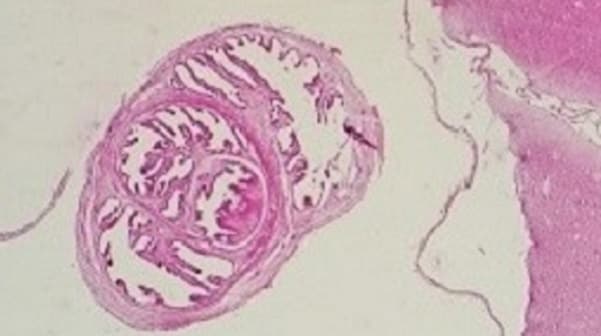Key points
- Cysticercosis is an infection caused by the larvae (young worms) of tapeworms.
- You develop cysticercosis after swallowing tapeworm eggs.
- Symptoms can occur months to years after infection

Overview
Cysticercosis is an infection caused by the larvae of the parasite Taenia solium. This infection occurs after a person swallows tapeworm eggs. The larvae get into tissues such as muscle, brain, and eye, and form cysts called cysticerci. When cysts are found in the brain or central nervous system, it is called neurocysticercosis.
Signs and symptoms
Signs and symptoms depend on the location and number of cysts in your body. Symptoms can occur months to years after infection, usually when the cysts start dying.
How it spreads
You get cysticercosis when you swallow tapeworm (T. solium) eggs. The eggs are passed in the feces (poop) of someone with a tapeworm. Tapeworm eggs can get in or on food, water, or surfaces contaminated with feces. People swallow the eggs when they consume contaminated food or water or put contaminated fingers in their mouth. Autoinfection is when someone with a tapeworm infects themselves with tapeworm eggs. They can also infect others in the family. Eating pork cannot give you cysticercosis.
Prevention
You can take steps to prevent cysticercosis.
Sanitation and hygiene precautions
- Wash your hands with soap and warm water after using the toilet, changing diapers, and before handling food.
- Teach children the importance of handwashing to prevent infection.
Food precautions
- Wash and peel fruits and vegetables before eating them.
- Avoid food or water that may be contaminated.
- When traveling in countries where the water supply may be unsafe, drink only
- Bottled water
- Water that has been boiled for one minute
- Carbonated (bubbly) drinks in sealed containers
- Bottled water
Diagnosis
If you think that you may have cysticercosis, please see your healthcare provider. They will ask you about:
- Your signs and symptoms
- Where you have traveled
- Kinds of foods you eat
Diagnosing neurocysticercosis typically involves MRI or CT brain scans and sometimes blood tests. Blood tests might not show positive results in mild infections. If surgery is needed, a pathologist will examine the cyst for diagnosis.
See additional information on testing for intestinal tapeworm infections on the taeniasis site.
Treatment
Infections are generally treated with a combination of anti-parasitic drugs and anti-inflammatory drugs. Surgery is sometimes necessary to treat cysts depending on:
- Location of the cyst
- The patient's response to drug treatment
- Amount of brain swelling
Treatment isn't always necessary for every case of cysticercosis. Even if you don't need treatment to kill the parasite, you may need treatment for the symptoms caused by the infection, such as medication to reduce seizures.
